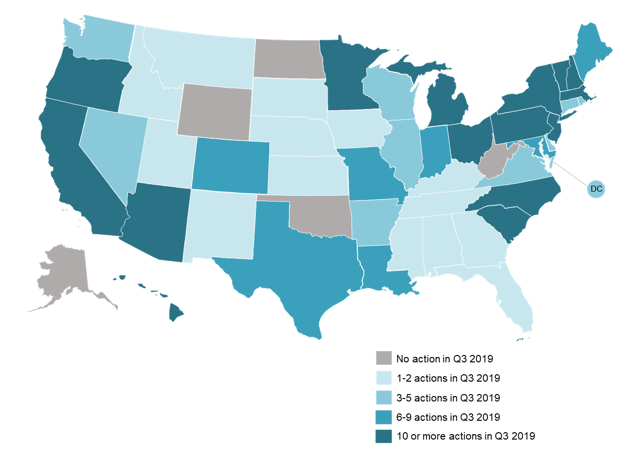The 50 States of Grid Modernization: Energy Storage and Rate Design Activity Front and Center in Q3 2019
Raleigh, NC – (October 30, 2019) The N.C. Clean Energy Technology Center (NCCETC) released its Q3 2019 edition of The 50 States of Grid Modernization. The quarterly series provides insights on state regulatory and legislative discussions and actions on grid modernization, utility business model and rate reforms, energy storage, microgrids, and demand response.
The report finds that 45 states, as well as the District of Columbia, took actions related to grid modernization during Q3 2019 (see figure below), with the greatest number of actions relating to energy storage deployment, data access policies, distribution system planning, integrated resource planning, and deployment of smart grid technologies.
A total of 383 grid modernization actions were taken during Q3 2019. Activity decreased from Q2 2019, due to most state legislatures adjourning in the first half of the year. However, total grid modernization activity during Q3 2019 represented a 39% increase over Q3 2018, with utilities proposing several new grid modernization and rate design plans. New York, Massachusetts, and California took the greatest number of actions during the quarter, followed by Minnesota, New Jersey, Hawaii, Michigan, and North Carolina.
Q3 2019 Legislative and Regulatory Action on Grid Modernization

The report discusses three trends in grid modernization actions taken in Q3 2019: (1) utilities filing innovative rate design proposals incorporating elements such as time-of-use rates, critical peak pricing, peak time rebates, and demand charges; (2) utility integrated resource plans increasingly including energy storage capacity additions; and (3) states and utilities developing online energy data portals.
“Of the 45 states taking grid modernization actions during the quarter, 40 took actions related to energy storage,” said Autumn Proudlove, lead author of the report and Senior Manager of Policy Research at NCCETC. “Utility integrated resource plans are increasingly including new energy storage capacity, while states continue to evaluate how energy storage is addressed in resource planning rules.”
The report notes the top five policy developments of Q3 2019 were:
- Maryland regulators issuing a decision on alternative ratemaking;
- Utilities filing revised grid modernization plans in North Carolina and Virginia;
- Massachusetts regulators rejecting National Grid’s proposed performance incentive mechanisms;
- The California Public Utilities Commission opening a microgrid rulemaking; and
- The North Carolina Department of Environmental Quality releasing its Clean Energy Plan.
“As grid modernization technologies have become more widespread, utilities are also pursuing new rate designs, such as critical peak pricing and peak time rebates, that make use of the data and functionality made available by new technologies,” observed David Sarkisian, Senior Policy Analyst at NCCETC.
View the 50 States of Grid Modernization Q3 2019 Executive Summary
View and Purchase the 50 States of Solar Q3 2019 update FULL Report
View other 50 States Reports – Solar, Grid Modernization and Electric Vehicles
ABOUT THE N.C. CLEAN ENERGY TECHNOLOGY CENTER
The N.C. Clean Energy Technology Center, as part of the College of Engineering at North Carolina State University, advances a sustainable energy economy by educating, demonstrating and providing support for clean energy technologies, practices and policies. It serves as a resource for innovative, sustainable energy technologies through technology demonstration, technical assistance, outreach and training. For more information about the Center, visit: http://www.nccleantech.ncsu.edu. Twitter: @NCCleanTech
MEDIA CONTACT: Shannon Helm, NCCETC, shannon_helm@ncsu.edu